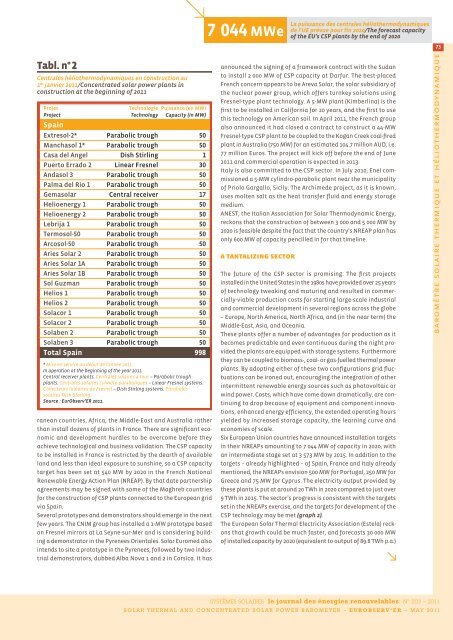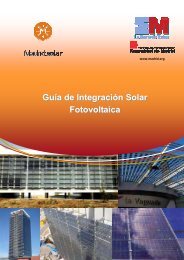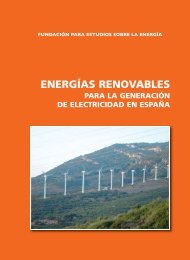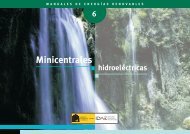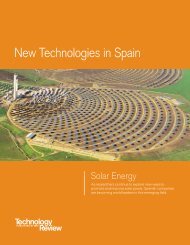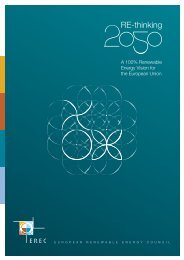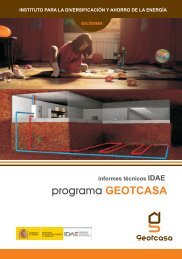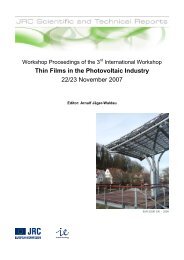BAROMÃTRE SOLAIRE THERMIQUE ET - EurObserv'ER
BAROMÃTRE SOLAIRE THERMIQUE ET - EurObserv'ER
BAROMÃTRE SOLAIRE THERMIQUE ET - EurObserv'ER
Create successful ePaper yourself
Turn your PDF publications into a flip-book with our unique Google optimized e-Paper software.
73baromètre solaire thermique et héliothermodynamique<br />
7 044 MWe<br />
La puissance des centrales héliothermodynamiques<br />
de l’UE prévue pour fin 2020/The forecast capacity<br />
of the EU’s CSP plants by the end of 2020<br />
Tabl. n°2<br />
Centrales héliothermodynamiques en construction au<br />
1 er janvier 2011/Concentrated solar power plants in<br />
construction at the beginning of 2011<br />
Projet<br />
Project<br />
Spain<br />
Technologie Puissance (en MW)<br />
Technology Capacity (in MW)<br />
Extresol-2* Parabolic trough 50<br />
Manchasol 1* Parabolic trough 50<br />
Casa del Angel Dish Stirling 1<br />
Puerto Errado 2 Linear Fresnel 30<br />
Andasol 3 Parabolic trough 50<br />
Palma del Rio 1 Parabolic trough 50<br />
Gemasolar Central receiver 17<br />
Helioenergy 1 Parabolic trough 50<br />
Helioenergy 2 Parabolic trough 50<br />
Lebrija 1 Parabolic trough 50<br />
Termosol-50 Parabolic trough 50<br />
Arcosol-50 Parabolic trough 50<br />
Aries Solar 2 Parabolic trough 50<br />
Aries Solar 1A Parabolic trough 50<br />
Aries Solar 1B Parabolic trough 50<br />
Sol Guzman Parabolic trough 50<br />
Helios 1 Parabolic trough 50<br />
Helios 2 Parabolic trough 50<br />
Solacor 1 Parabolic trough 50<br />
Solacor 2 Parabolic trough 50<br />
Solaben 2 Parabolic trough 50<br />
Solaben 3 Parabolic trough 50<br />
Total Spain 998<br />
* Mise en service au début de l’année 2011.<br />
In operation at the beginning of the year 2011.<br />
Central receiver plants. Centrales solaires à tour – Parabolic trough<br />
plants. Centrales solaires cylindro-paraboliques – Linear Fresnel systems.<br />
Collecteurs linéaires de Fresnel – Dish Stirling systems. Paraboles<br />
solaires Dish Sterling.<br />
Source : EurObserv’ER 2011.<br />
ranean countries, Africa, the Middle-East and Australia rather<br />
than install dozens of plants in France. There are significant economic<br />
and development hurdles to be overcome before they<br />
achieve technological and business validation. The CSP capacity<br />
to be installed in France is restricted by the dearth of available<br />
land and less than ideal exposure to sunshine, so a CSP capacity<br />
target has been set at 540 MW by 2020 in the French National<br />
Renewable Energy Action Plan (NREAP). By that date partnership<br />
agreements may be signed with some of the Maghreb countries<br />
for the construction of CSP plants connected to the European grid<br />
via Spain.<br />
Several prototypes and demonstrators should emerge in the next<br />
few years. The CNIM group has installed a 1-MW prototype based<br />
on Fresnel mirrors at La Seyne-sur-Mer and is considering building<br />
a demonstrator in the Pyrenees Orientales. Solar Euromed also<br />
intends to site a prototype in the Pyrenees, followed by two industrial<br />
demonstrators, dubbed Alba Nova 1 and 2 in Corsica. It has<br />
announced the signing of a framework contract with the Sudan<br />
to install 2 000 MW of CSP capacity at Darfur. The best-placed<br />
French concern appears to be Areva Solar, the solar subsidiary of<br />
the nuclear power group, which offers turnkey solutions using<br />
Fresnel-type plant technology. A 5-MW plant (Kimberlina) is the<br />
first to be installed in California for 20 years, and the first to use<br />
this technology on American soil. In April 2011, the French group<br />
also announced it had closed a contract to construct a 44-MW<br />
Fresnel-type CSP plant to be coupled to the Kogan Creek coal-fired<br />
plant in Australia (750 MW) for an estimated 104.7 million AUD, i.e.<br />
77 million Euros. The project will kick off before the end of June<br />
2011 and commercial operation is expected in 2013.<br />
Italy is also committed to the CSP sector. In July 2010, Enel commissioned<br />
a 5-MW cylindro-parabolic plant near the municipality<br />
of Priolo Gargallo, Sicily. The Archimede project, as it is known,<br />
uses molten salt as the heat transfer fluid and energy storage<br />
medium.<br />
ANEST, the Italian Association for Solar Thermodynamic Energy,<br />
reckons that the construction of between 3 000 and 5 000 MW by<br />
2020 is feasible despite the fact that the country’s NREAP plan has<br />
only 600 MW of capacity pencilled in for that timeline.<br />
a tantalizing sector<br />
The future of the CSP sector is promising. The first projects<br />
installed in the United States in the 1980s have provided over 25 years<br />
of technology tweaking and maturing and resulted in commercially-viable<br />
production costs for starting large-scale industrial<br />
and commercial development in several regions across the globe<br />
– Europe, North America, North Africa, and (in the near term) the<br />
Middle-East, Asia, and Oceania.<br />
These plants offer a number of advantages for production as it<br />
becomes predictable and even continuous during the night provided<br />
the plants are equipped with storage systems. Furthermore<br />
they can be coupled to biomass-, coal- or gas-fuelled thermal power<br />
plants. By adopting either of these two configurations grid fluctuations<br />
can be ironed out, encouraging the integration of other<br />
intermittent renewable energy sources such as photovoltaic or<br />
wind power. Costs, which have come down dramatically, are continuing<br />
to drop because of equipment and component innovations,<br />
enhanced energy efficiency, the extended operating hours<br />
yielded by increased storage capacity, the learning curve and<br />
economies of scale.<br />
Six European Union countries have announced installation targets<br />
in their NREAPs amounting to 7 044 MW of capacity in 2020, with<br />
an intermediate stage set at 3 573 MW by 2015. In addition to the<br />
targets – already highlighted – of Spain, France and Italy already<br />
mentioned, the NREAPs envision 500 MW for Portugal, 250 MW for<br />
Greece and 75 MW for Cyprus. The electricity output provided by<br />
these plants is put at around 20 TWh in 2020 compared to just over<br />
9 TWh in 2015. The sector’s progress is consistent with the targets<br />
set in the NREAPs exercise, and the targets for development of the<br />
CSP technology may be met (graph 2).<br />
The European Solar Thermal Electricity Association (Estela) reckons<br />
that growth could be much faster, and forecasts 30 000 MW<br />
of installed capacity by 2020 (equivalent to output of 89.8 TWh p.a.)<br />
SYSTÈMES <strong>SOLAIRE</strong>S le journal des énergies renouvelables N° 203 – 2011<br />
SOLAR THERMAL AND CONCENTRATED SOLAR POWER BAROM<strong>ET</strong>ER – EUROBSERV’ER – MAY 2011


